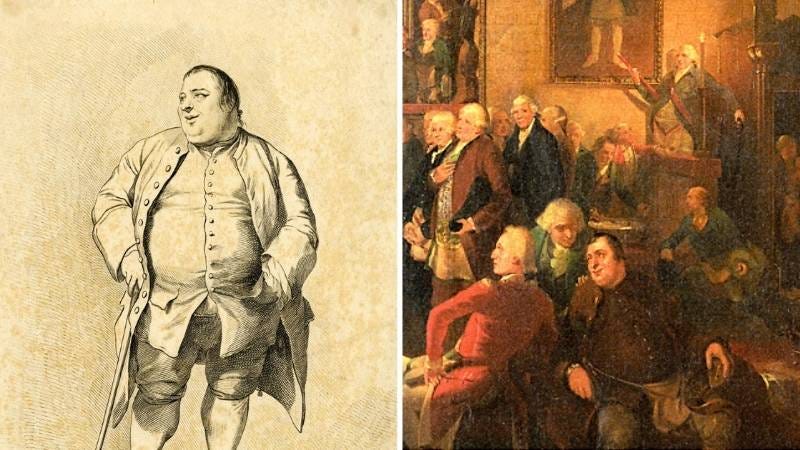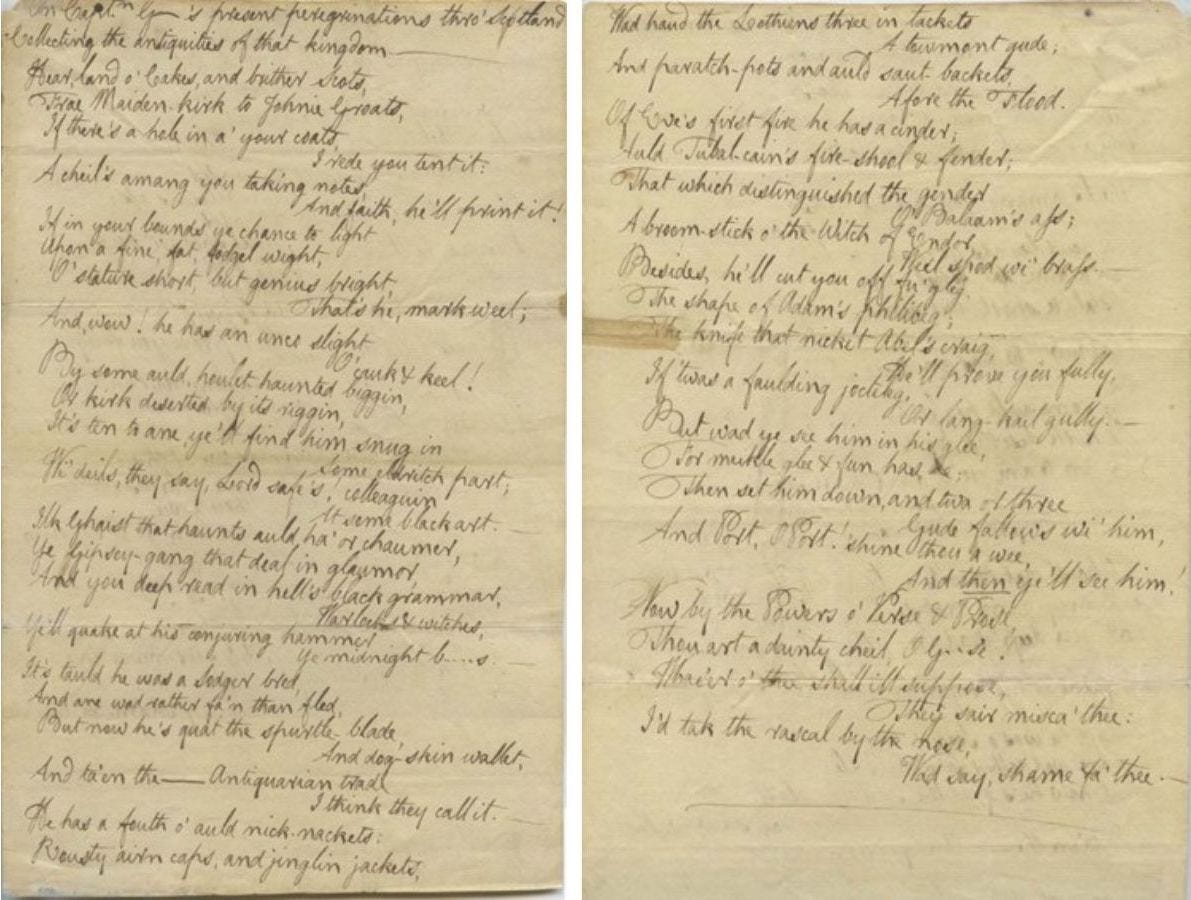Auld Alloway Kirk and Tam O' Shanter
Bro. Francis Grose, the author and Freemason that presented the occasion for Bro. Robert Burns to write his famous tale of Tam O' Shanter and created the imagery that was published alongside it.
As we approach January 25th, the anniversary of the birth of Scotland acclaimed poet, songwriter and Freemason Bro. Robert Burns, we would all traditionally be gathering to celebrate his life and work. Sadly with the ongoing pandemic this is unlikely to happen for most of us, however I thought it appropriate to look at some specific Burns related pieces.
Bro. Robert Burns is undoubtedly one of Scotland’s, if not the, most famous Freemasons and it is a sad fact that his passion for and dedication to the Craft of Freemasonry is often wiped from history when people discuss “Caledonia’s Bard”. Whilst I enjoy hearing about his exploits, and listening to impressive recitation of pieces such as Tam O’Shanter; as a Freemason, it’s his Masonic career and connections that I find most fascinating.

Revisiting “The Inauguration”
I recently published a piece looking at the famous ‘Inauguration of Robert Burns as Poet Laureate of Lodge Canongate Kilwinning’ by artist and Freemason Bro. Stewart Watson along with the various versions of the painting. If you have read this edition it can be found here ‘Spot the difference with Robert Burns’.
Within the ‘inauguration painting’ we find the somewhat full figure of Bro. Capt. Francis Grose at the bottom right of the scene. Looking on at the proceedings from behind the gentleman dressed in the red military uniform.
Watson painted ‘the Inauguration’ 50 years following the death of Burns and 55 years following the death of Bro. Francis Grose, and as such clearly used what was available to him as reference at the time. In the case of Grose it was the frontispiece from his book ‘Antiquities of England and Wale’ published in 1772, a portrait by artist Nathaniel Dance, himself a member of the Craft and known for many portraits of prominent Freemasons.

Bro. Capt. Francis Grose (1731 - 1791)
Francis Grose was the son of a Swiss watch maker and Jeweller who practiced his trade in London. As such, and as suggested in the inauguration painting and comments from Burns himself, Grose didn’t appear to have to work terribly hard or physically for his living. He inherited his father’s considerable fortune from creating watches for the aristocracy and indeed to this day Grose watches are still highly sought after.
Aside from being a Captain in the Surrey Miltia, Francis Grose’s chosen line of work was somewhat different to that of his father, more leisurely travelling around the country visiting taverns where he would collect old folk tales and stories, publishing them in book such as his ‘Antiquities of England and Wales’ the first edition of which was released in 1772. This was followed up by an effort by the author to do the same in Scotland where he probably heard how many pubs we have North of the border.
With his books Grose included many of his own highly detailed illustrations, mainly of buildings and is one of the earliest examples of someone systematically documenting architecture in the UK in this manner.
In many ways what Grose was doing was similar to that of Robert Burns albeit with traditional tales rather than old Scottish songs. That common interest, and with the added connection through Freemasonry, would have been attractive to Grose who met with Burns during the summer of 1789 whilst in Scotland at Friars Carse in Dumfries.
Burns had suggested that the ‘Aloa Church in Ayrshire’ be included as an antiquity in Grose’s book, for which Grose then requested a story from the poet to include with it. Burns agreed but only in return for an illustration of the Alloway Kirk.
There was a very particular reason for this request, as the poem written for Grose’s book was none other than the famous tale of Tam O’Shanter and Burns wanted something accompany this master piece.
With the obvious inherited security of Grose, he was under no financial pressure to publish his work and therefore no apparent rush. So despite the original agreement being that Tam O’Shanter would be published in the second volume of his “Antiquities of Scotland” Burns initially publishes it himself within two Edinburgh periodicals dated March 1791 a month prior to the publication of Grose’s book.
True to his word however, Tam O’Shanter was included in Volume II of ‘Antiquities of Scotland’ with the illustration of Alloway Kirk on the opposite page and included a paragraph in the introduction that read:
“To my ingenious friend Mr Robert Burns I have been variously obligated; he not only was at pains of marking out what was worthy of note in Ayrshire, the county of his honoured birth, but he also wrote, expressly for this work, the pretty tale annexed to Alloway Church.”
Bro. Robert Burns tells us of Capt. Francis Grose in a poem published in the Edinburgh Evening Courant, in August 1789 of ‘On The Late Captain Grose’s Pereginations Thro’ Scotland Collecting The Antiquities Of That Kingdom’ submitted under the pen name Thomas A. Linn which I have included at the end for those that wish to the Scots language in it’s fullest.
And also in a letter written to his dearest friend, supporter and patron; Mrs Frances Anna Wallace Dunlop ‘Mrs Dunlop’ to tell her of Grose.
“As he has made his headquarters with Captn Riddel, my nearest neighbour, for these two months, I am intimately acquainted with him; & I have never seen a man of more original observation, anecdote & remark .... His delight is to steal thro' the country almost unknown, both as most favourable to his humour & his business… if you discover a cheerful-looking grig of an old fat fellow, the precise figure of Dr Slop, wheeling about your avenue in his own carriage with a pencil & paper in his hand, you may conclude, "Thou art the man!"
“On The Late Captain Grose’s Pereginations Thro’ Scotland Collecting The Antiquities Of That Kingdom”
Hear, Land o' Cakes, and brither Scots,
Frae Maidenkirk to Johnie Groat's; -
If there's a hole in a' your coats,
I rede you tent it:
A chield's amang you takin notes,
And, faith, he'll prent it:
If in your bounds ye chance to light
Upon a fine, fat fodgel wight,
O' stature short, but genius bright,
That's he, mark weel;
And wow! he has an unco sleight
O' cauk and keel.
By some auld, houlet-haunted biggin,
Or kirk deserted by its riggin,
It's ten to ane ye'll find him snug in
Some eldritch part,
Wi' deils, they say, Lord save's! colleaguin
At some black art.
Ilk ghaist that haunts auld ha' or chaumer,
Ye gipsy-gang that deal in glamour,
And you, deep-read in hell's black grammar,
Warlocks and witches,
Ye'll quake at his conjuring hammer,
Ye midnight bitches.
It's tauld he was a sodger bred,
And ane wad rather fa'n than fled;
But now he's quat the spurtle-blade,
And dog-skin wallet,
And taen the - Antiquarian trade,
I think they call it.
He has a fouth o' auld nick-nackets :
Rusty airn caps and jinglin jackets,
Wad haud the Lothians three in tackets,
A towmont gude;
And parritch-pats and auld saut-backets,
Before the Flood.
Of Eve's first fire he has a cinder;
Auld Tubalcain's fire-shool and fender;
That which distinguished the gender
O' Balaam's ass:
A broomstick o' the witch of Endor,
Weel shod wi' brass.
Forbye, he'll shape you aff fu' gleg
The cut of Adam's philibeg;
The knife that nickit Abel's craig
He'll prove you fully,
It was a faulding jocteleg,
Or lang-kail gullie.
But wad ye see him in his glee,
For meikle glee and fun has he,
Then set him down, and twa or three
Gude fellows wi' him:
And port, O port! shine thou a wee,
And Then ye'll see him!
Now, by the Pow'rs o' verse and prose!
Thou art a dainty chield, O Grose! -
Whae'er o' thee shall ill suppose,
They sair misca' thee;
I'd take the rascal by the nose,
Wad say, "Shame fa' thee!"



